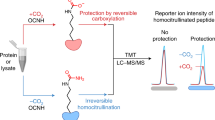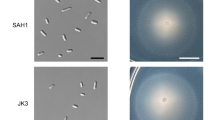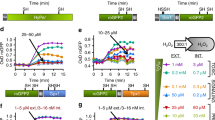Abstract
Carbon dioxide not only plays a central role in the carbon cycle, but also acts as a crucial signal in living cells. Adaptation to changing CO2 concentrations is critical for all organisms. Conversion of CO2 to HCO3− by carbonic anhydrase and subsequent HCO3−-triggered signalling are thought to be important for cellular responses to CO2 (refs. 1,2,3). However, carbonic anhydrases are suggested to transduce a change in CO2 rather than be a direct CO2 sensor4,5, the mechanism(s) by which organisms sense CO2 remain unknown. Here we demonstrate that a unique group of PP2C phosphatases from fungi and plants senses CO2, but not HCO3−, to control diverse cellular programmes. Different from other phosphatases, these PP2Cs all have an intrinsically disordered region (IDR). They formed reversible liquid-like droplets through phase separation both in cells and in vitro, and were activated in response to elevated environmental CO2 in an IDR-dependent manner. The IDRs in PP2Cs are characterized by a sequence of polar amino acids enriched in serine/threonine, which provides CO2 responsiveness. CO2-responsive activation of PP2Cs via the serine/threonine-rich IDR-mediated phase separation represents a direct CO2 sensing mechanism and is widely exploited.
This is a preview of subscription content, access via your institution
Access options
Access Nature and 54 other Nature Portfolio journals
Get Nature+, our best-value online-access subscription
$29.99 / 30 days
cancel any time
Subscribe to this journal
Receive 12 print issues and online access
$209.00 per year
only $17.42 per issue
Buy this article
- Purchase on Springer Link
- Instant access to full article PDF
Prices may be subject to local taxes which are calculated during checkout





Similar content being viewed by others
Data availability
Protein sequence data for proteins CaPtc2, ScPtc2, CnPtc2, AP2C3, PP2C74, Sup35 and FUS that were re-analysed here are available from UniProt under accession codes A0A1D8PRZ8, P39966, F5HBU9, F6LPR7, A0A1P8BC27, P05453 and P35637, respectively. All other data supporting the findings of this study are available from the corresponding author on reasonable request. Source data are provided with this paper.
References
Chen, Y. Q. et al. Soluble adenylyl cyclase as an evolutionarily conserved bicarbonate sensor. Science 289, 625–628 (2000).
Klengel, T. et al. Fungal adenylyl cyclase integrates CO2 sensing with cAMP signaling and virulence. Curr. Biol. 15, 2021–2026 (2005).
Bahn, Y. S., Cox, G. M., Perfect, J. R. & Heitman, J. Carbonic anhydrase and CO2 sensing during Cryptococcus neoformans growth, differentiation, and virulence. Curr. Biol. 15, 2013–2020 (2005).
Hu, H. H. et al. Carbonic anhydrases are upstream regulators of CO2-controlled stomatal movements in guard cells. Nat. Cell Biol. 12, 87–U234 (2010).
Frommer, W. B. CO(2)mmon sense. Science 327, 275–276 (2010).
Lu, Y., Su, C., Ray, S., Yuan, Y. C. & Liu, H. P. CO2 Signaling through the Ptc2–Ssn3 axis governs sustained hyphal development of Candida albicans by reducing Ume6 phosphorylation and degradation. Mbio https://doi.org/10.1128/mBio.02320-18 (2019).
Lin, Y., Protter, D. S., Rosen, M. K. & Parker, R. Formation and maturation of phase-separated liquid droplets by RNA-binding proteins. Mol. Cell 60, 208–219 (2015).
Nott, T. J. et al. Phase transition of a disordered nuage protein generates environmentally responsive membraneless organelles. Mol. Cell 57, 936–947 (2015).
Patel, A. et al. A liquid-to-solid phase transition of the ALS protein FUS accelerated by disease mutation. Cell 162, 1066–1077 (2015).
Li, P. et al. Phase transitions in the assembly of multivalent signalling proteins. Nature 483, 336–340 (2012).
Yoo, H., Triandafillou, C. & Drummond, D. A. Cellular sensing by phase separation: using the process, not just the products. J. Biol. Chem. 294, 7151–7159 (2019).
Riback, J. A. et al. Stress-triggered phase separation is an adaptive, evolutionarily tuned response. Cell 168, 1028–1040 (2017).
Franzmann, T. M. et al. Phase separation of a yeast prion protein promotes cellular fitness. Science https://doi.org/10.1126/science.aao5654 (2018).
Du, M. & Chen, Z. J. DNA-induced liquid phase condensation of cGAS activates innate immune signaling. Science 361, 704–709 (2018).
Su, X. et al. Phase separation of signaling molecules promotes T cell receptor signal transduction. Science 352, 595–599 (2016).
Zhang, J. Z. et al. Phase separation of a PKA regulatory subunit controls cAMP compartmentation and oncogenic signaling. Cell 182, 1531–1544 e1515 (2020).
Klosin, A. et al. Phase separation provides a mechanism to reduce noise in cells. Science 367, 464–468 (2020).
Moses, D. et al. Revealing the hidden sensitivity of intrinsically disordered proteins to their chemical environment. J. Phys. Chem. Lett. 11, 10131–10136 (2020).
Wang, J. et al. A molecular grammar governing the driving forces for phase separation of prion-like RNA binding proteins. Cell 174, 688 (2018).
Huang, G., Srikantha, T., Sahni, N., Yi, S. & Soll, D. R. CO2 regulates white-to-opaque switching in Candida albicans. Curr. Biol. 19, 330–334 (2009).
Zaragoza, O., Fries, B. C. & Casadevall, A. Induction of capsule growth in Cryptococcus neoformans by mammalian serum and CO2. Infect. Immun. 71, 6155–6164 (2003).
Miller, M. G. & Johnson, A. D. White-opaque switching in Candida albicans is controlled by mating-type locus homeodomain proteins and allows efficient mating. Cell 110, 293–302 (2002).
Huang, G. H. et al. Bistable expression of WOR1, a master regulator of white–opaque switching in Candida albicans. Proc. Natl Acad. Sci. USA 103, 12813–12818 (2006).
Zordan, R. E., Galgoczy, D. J. & Johnson, A. D. Epigenetic properties of white–opaque switching in Candida albicans are based on a self-sustaining transcriptional feedback loop. Proc. Natl Acad. Sci. USA 103, 12807–12812 (2006).
Alkafeef, S. S., Yu, C., Huang, L. & Liu, H. P. Wor1 establishes opaque cell fate through inhibition of the general co-repressor Tup1 in Candida albicans. PLoS Genet. https://doi.org/10.1371/journal.pgen.1007176 (2018).
Blom, N., Sicheritz-Ponten, T., Gupta, R., Gammeltoft, S. & Brunak, S. Prediction of post-translational glycosylation and phosphorylation of proteins from the amino acid sequence. Proteomics 4, 1633–1649 (2004).
Vyas, V. K., Barrasa, M. I. & Fink, G. R. A Candida albicans CRISPR system permits genetic engineering of essential genes and gene families. Sci. Adv. 1, e1500248 (2015).
Woodward, F. I. Stomatal numbers are sensitive to increases in CO2 from preindustrial levels. Nature 327, 617–618 (1987).
Engineer, C. B. et al. CO2 sensing and CO2 regulation of stomatal conductance: advances and open questions. Trends Plant Sci. 21, 16–30 (2016).
Tsugama, D., Liu, S. & Takano, T. A putative myristoylated 2C-type protein phosphatase, PP2C74, interacts with SnRK1 in Arabidopsis. FEBS Lett. 586, 693–698 (2012).
Brock, A. K. et al. The Arabidopsis mitogen-activated protein kinase phosphatase PP2C5 affects seed germination, stomatal aperture, and abscisic acid-inducible gene expression. Plant Physiol. 153, 1098–1111 (2010).
Jung, J. H. et al. A prion-like domain in ELF3 functions as a thermosensor in Arabidopsis. Nature 585, 256–260 (2020).
Leung, K., Nielsen, I. M. B. & Kurtz, I. Ab Initio molecular dynamics study of carbon dioxide and bicarbonate hydration and the nucleophilic attack of hydroxide on CO2. J. Phys. Chem. B 111, 4453–4459 (2007).
Cundari, T. R. et al. CO2-formatics: how do proteins bind carbon dioxide? J. Chem. Inf. Model. 49, 2111–2115 (2009).
Alberti, S., Gladfelter, A. & Mittag, T. Considerations and challenges in studying liquid-liquid phase separation and biomolecular condensates. Cell 176, 419–434 (2019).
Peeples, W. & Rosen, M. K. Mechanistic dissection of increased enzymatic rate in a phase-separated compartment. Nat. Chem. Biol. 17, 693–702 (2021).
Tibble, R. W., Depaix, A., Kowalska, J., Jemielity, J. & Gross, J. D. Biomolecular condensates amplify mRNA decapping by biasing enzyme conformation. Nat. Chem. Biol. 17, 615–623 (2021).
Kim, T. H. et al. Phospho-dependent phase separation of FMRP and CAPRIN1 recapitulates regulation of translation and deadenylation. Science 365, 825–829 (2019).
Lammers, T. & Lavi, S. Role of type 2C protein phosphatases in growth regulation and in cellular stress signaling. Crit. Rev. Biochem. Mol. 42, 437–461 (2007).
Fan, C. L. et al. The Cys2His2 zinc finger protein Zfp1 regulates sexual reproduction and virulence in Cryptococcus neoformans. Fungal Genet. Biol. 124, 59–72 (2019).
Reuss, O., Vik, A., Kolter, R. & Morschhauser, J. The SAT1 flipper, an optimized tool for gene disruption in Candida albicans. Gene 341, 119–127 (2004).
Acknowledgements
We thank the members of Lu laboratory for critical discussion and M. Peterson from Liu laboratory for editing the manuscript. We thank S. Sandmeyer and S. Du for strains and plasmids. This work was supported by grants from National Natural Science Foundation of China (31770162 and 32070074 to Y.L., 81973370 and 32170089 to C.S. and 22077094 to C.Z.), a National Key Research and Development Program of China grant (2020YFA0908501 to C.Z.) and a National Institute of General Medical Sciences grant (2R02GM117111-05 to H.L.).
Author information
Authors and Affiliations
Contributions
Y.L., C.S., M.Z. and H.L. designed the experiments. M.Z., Y.D., T.L. and C.S. performed the experiments. M.Z., C.Z., Y.L. and C.S. performed data analyses. Y.L., C.S., M.Z. and H.L. wrote the paper with input from the co-authors.
Corresponding authors
Ethics declarations
Competing interests
The authors declare no competing interests.
Peer review
Peer review information
Nature Cell Biology thanks the anonymous reviewers for their contribution to the peer review of this work. Peer reviewer reports are available.
Additional information
Publisher’s note Springer Nature remains neutral with regard to jurisdictional claims in published maps and institutional affiliations.
Extended data
Extended Data Fig. 1 Ptc2 protein level is not regulated by CO2 and ectopically expressed Ptc2 cannot promote sustained hyphal development.
a. Western blot analysis of Ptc2-Myc. Wild type cells carrying Ptc2-Myc under its endogenous promoter were incubated in YEPD medium at 30 °C in air or in 5% CO2 for 4 h. b. Overnight cultures of wild type carrying vector or TDH3p-PTC2 were diluted into YEPSucrose medium at 37 °C. Half of the samples was put into the CO2 incubator immediately. The other sample was incubated in air. Cell morphology was examined after incubation of 12 h. The number of cells used for quantification: vector-Air, n=160, 98, 209; vector-CO2, n=105, 92, 106; PTC2-Air, n=119, 139, 128; PTC2-CO2, n=123, 101, 113. The data show the average from three independent experiments. The cells which had a length/width ratio of >4.5 and characteristic shape were considered hyphae. Scale bar, 20 μm.Numerical data and unprocessed blots are available in the source data.
Extended Data Fig. 2
Sequence identity (%) of the N-terminal PP2C domain and the C-terminal domain of Ptc2 in three indicated yeasts.
Extended Data Fig. 3 CO2 does not significantly affect the saturation concentration of Sup35 and FUS.
a. 5% CO2 significantly decreases the saturation concentration of CaPtc2 whereas pH only marginally influences it. Phase separation of GFP-CaPtc2 under the indicated conditions. Phase separation quantified by the relative amount of condensed protein versus the protein concentration. Images on left were used for the quantification. b. The IDR from Sup35 does not respond to CO2 in driving phase separation. Phase separation of Sup35-GFP and the chimeric construct GFP-Ptc2∆IDR-Sup35IDR under the indicated conditions. Images above were used for the quantification. c. The saturation concentration of FUS does not change significantly in 5% CO2. Phase separation of FUS-GFP and the chimeric construct GFP-Ptc2∆IDR-FUSIDR under the indicated conditions. Images above were used for the quantification. a-c, Scale bar, 5 μm. The saturation concentration is indicated by arrows. Data shown as means ± SD of three independent experiments. Numerical data are available in the source data.
Extended Data Fig. 4 HCO3- is unable to induce condensates formation of Ptc2 in fungi.
Recombinant GFP-Ptc2 protein droplets formation in the presence of 25 mM NaHCO3. Representative images of three independent experiments are shown. Scale bar, 2 μm.
Extended Data Fig. 5 Ptc2-mediated CO2 sensing mechanism is conserved in fungi.
a. Ptc2 is required for CO2-responsive capsule formation in C. neoformans. Cells of wild type and ptc2 mutant were grown in DME medium in air or 5% CO2 (left and middle column), or in PBS with 10% serum (right column). India ink images were shown after incubation for 6 h. Scale bar, 5 μm. b. Ptc2 controls CO2-responsive carbonic anhydrase expression in yeasts. Exponential cultures of indicated C. albicans, S. cerevisiae and C. neoformans strains were cultivated at 30 °C as duplicates in 5% CO2 for 4 h, and then one duplicate was transferred to air for 60 min to induce carbonic anhydrase expression. The expression was quantified by qRT-PCR analysis and normalized with ACT1. Data shown as means ± SD of three independent experiments. Statistical analysis was performed using an unpaired two-tailed Student’s t-test. Numerical data are available in the source data.
Extended Data Fig. 6 Ptc2 regulates CO2-responsive hyphal elongation (a) and carbonic anhydrase expression (b) in an IDR-dependent manner in C. albicans.
Assays of ptc2 carrying PTC2 or PTC2ΔIDR under the control of ADH1promoter were performed as described in Extended Data Fig. 1b and Extended Data Fig. 5b. Scale bar, 20 μm. Data shown in (b) as means ± SD of three independent experiments. Statistical analysis was performed using an unpaired two-tailed Student’s t-test. Numerical data are available in the source data.
Extended Data Fig. 7 Coomassie blue staining of purified recombinant proteins used in this study.
Representative gel images of two independent experiments are shown.
Supplementary information
Source data
Source Data Fig. 1
Statistical source data.
Source Data Fig. 2
Statistical source data.
Source Data Fig. 3
Statistical source data.
Source Data Fig. 3
Unprocessed western blots.
Source Data Fig. 4
Statistical source data.
Source Data Fig. 5
Statistical source data.
Source Data Extended Data Fig. 1
Statistical source data.
Source Data Extended Data Fig. 1
Unprocessed western blots.
Source Data Extended Data Fig. 3
Statistical source data.
Source Data Extended Data Fig. 5
Statistical source data.
Source Data Extended Data Fig. 6
Statistical source data.
Rights and permissions
About this article
Cite this article
Zhang, M., Zhu, C., Duan, Y. et al. The intrinsically disordered region from PP2C phosphatases functions as a conserved CO2 sensor. Nat Cell Biol 24, 1029–1037 (2022). https://doi.org/10.1038/s41556-022-00936-6
Received:
Accepted:
Published:
Issue Date:
DOI: https://doi.org/10.1038/s41556-022-00936-6
This article is cited by
-
Phase separation in fungi
Nature Microbiology (2023)
-
CO2 sensing through PP2C condensates
Nature Reviews Molecular Cell Biology (2022)
-
Intrinsically disordered CO2 sensors
Nature Cell Biology (2022)



